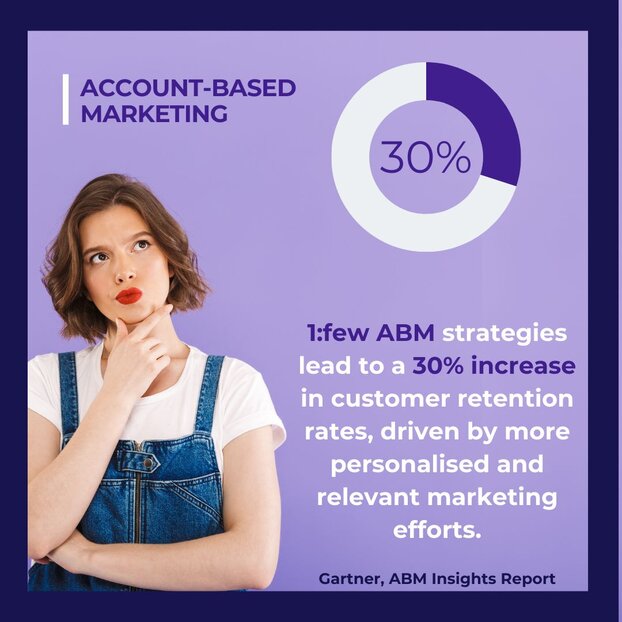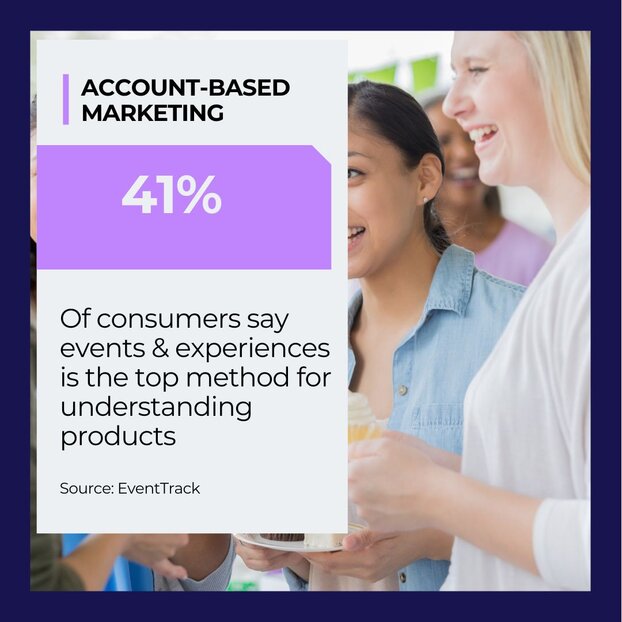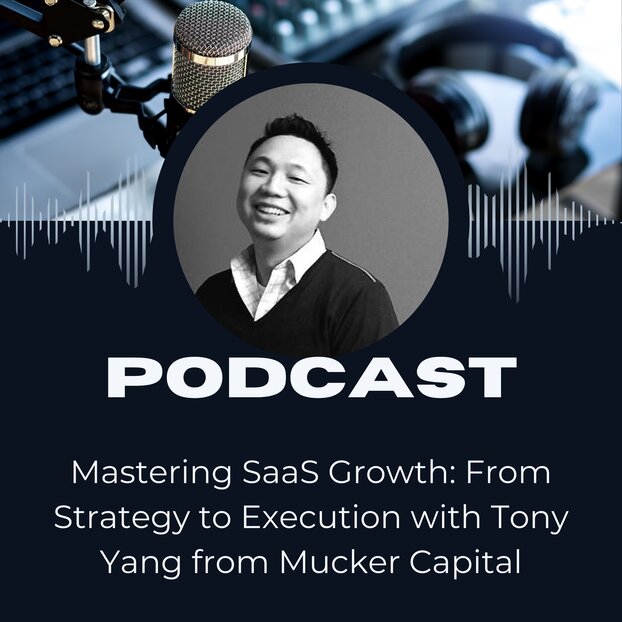1:few ABM
The Goldilocks Approach to Account-Based Marketing
1:few ABM, often affectionately dubbed "ABM Lite," is the middle ground in the world of Account-Based Marketing. It’s the perfect blend of the hyper-personalisation found in 1:1 ABM and the broader reach of 1:many ABM. Think of it as the Goldilocks of ABM strategies—not too narrow, not too wide, but just right.
In this approach, instead of going all-in on individual accounts like in 1:1 ABM, or casting a wide net like in 1:many ABM, you focus your efforts on small clusters of accounts. These accounts share commonalities—be it industry, challenges, or business goals—allowing you to create campaigns that resonate with them on a deeper level without stretching your resources too thin.
Key Characteristics:
- Number of Accounts: Typically, 1:few ABM targets 5 to 10 accounts per cluster. This group is small enough to allow for a degree of personalisation, but large enough to make the investment in ABM worthwhile.
- Personalisation Level: The personalisation here is moderate. You won’t be crafting bespoke campaigns for each account as you would in 1:1 ABM, but you’ll still be tailoring your messages and offerings to align with the specific needs and challenges of the cluster.

Use Cases:
- Reach a Broader Audience: One of the standout benefits of 1:few ABM is its ability to engage multiple accounts simultaneously that have similar needs and pain points. By crafting a message that speaks directly to a shared challenge or goal, you can efficiently reach a wider audience without diluting the impact of your message.
- Boost Brand Loyalty: With 1:few ABM, you can strengthen brand loyalty by addressing the specific needs of key accounts within the cluster. When these accounts see that your solutions are tailored to their unique circumstances, it deepens their connection to your brand and fosters long-term loyalty.
- Spot New Opportunities: 1:few ABM isn’t just about playing defense; it’s also about going on the offensive. By analysing data across your targeted accounts, you can identify new opportunities for upselling, cross-selling, or even expanding into adjacent markets. The insights gained from one account can often be applied to others within the cluster, maximising your ROI.
1:few ABM offers a balanced approach to targeted marketing. It provides a way to deliver personalised experiences at scale, making it a powerful tool for companies looking to drive growth in competitive markets.
Mastering ABM: From Strategy to Execution with Tony Yang from Mucker Capital
When it comes to executing a successful 1:few ABM strategy, Tony Yang, a seasoned expert in the field, emphasises the importance of personalisation and strategic relationship-building.
Listen to our interview on the SaaS Stories podcast called "Mastering SaaS Growth: From Strategy to Execution"
Here’s a breakdown of his approach to making 1:few ABM work, especially for high-ticket, enterprise-level deals.
1. Know Your Targets Inside Out
Tony starts by highlighting the need to thoroughly understand your target accounts and the key decision-makers within them. In 1:few ABM, it’s not enough to know the company—you need to know the people.
Identify the right individuals who hold the power to make purchasing decisions or influence them. This might involve roles like the Chief Information Security Officer (CISO), Chief Information Officer (CIO), or other senior executives, depending on the nature of your offering.
Once you've identified these key players, dive deep into understanding their specific responsibilities, challenges, and goals. What keeps them up at night? What are their key initiatives?
This level of insight allows you to craft messages and offers that resonate on a personal level, making it more likely that your outreach will catch their attention and build a meaningful connection.
2. Multi-Threaded Engagement
A critical strategy Tony discusses is the use of a multi-threaded approach. This involves engaging multiple stakeholders within the target account simultaneously. Instead of contacting one person in isolation, you reach out to several individuals within the decision-making group, each with a tailored message that acknowledges the broader context of your interactions.
For example, if you’ve already had a conversation with the CIO, your outreach to the CISO might reference that discussion, creating a sense of continuity and collaboration. This approach not only increases your chances of engagement but also demonstrates that you’re thoroughly invested in understanding and addressing the needs of the entire buying team.

3. Align Sales and Marketing Efforts
Tony stresses the importance of tight alignment between sales and marketing teams in executing a 1:few ABM strategy. Marketing’s role isn’t just to create leads—it’s to empower sales with the tools, assets, and intelligence they need to engage effectively. This could include:
- Custom Case Studies and ROI Calculators: Tailored to the specific challenges and goals of your target accounts, these resources provide concrete evidence of your value proposition.
- Exclusive Events and Experiences: Tony suggests hosting intimate events like C-level dinners or breakfast roundtables. If you know key decision-makers are attending a major industry event, invite them to a small, exclusive gathering where they can network with their peers and hear from existing customers who love your product. This personal touch can significantly enhance relationship-building efforts.
- Customer Advisory Boards: Establishing a customer advisory board can be another powerful tool. It allows you to engage deeply with existing customers while also creating opportunities for cross-selling and upselling to other business units or regions within the same account.
4. Personalised Outreach: Beyond the Generic
When it comes to the initial outreach, Tony warns against generic messages that lack relevance. In 1:few ABM, every touchpoint should be deeply personalised. This might mean referencing a specific challenge the target account is facing, tying your value proposition directly to their current initiatives, or even mentioning recent interactions with other stakeholders within the same company.
The goal is to make each message feel like it was crafted specifically for the recipient, which in turn increases the likelihood of a positive response.
5. Focus on Long-Term Relationship Building
Finally, Tony emphasises that 1:few ABM isn’t just about landing the first deal—it’s about building long-term relationships that lead to future opportunities. Whether it’s through land-and-expand strategies or by securing a significant upsell or cross-sell, the goal is to continually add value and deepen your connection with the account.
By combining these strategies—deep personalisation, multi-threaded engagement, and close sales-marketing alignment—you can create a 1:few ABM program that not only captures the attention of key decision-makers but also nurtures those relationships over the long term, driving substantial growth for your business.
This strategic approach, as outlined by Tony Yang, showcases how 1:few ABM can be a powerful tool for companies looking to win big in complex, high-value markets.
The key lies in understanding your targets, aligning your teams, and maintaining a relentless focus on building relationships that last.
ABM is a game-changer for B2B marketing. By focusing on high-value accounts and delivering personalized campaigns, ABM allows companies to be more strategic and targeted in their marketing efforts, resulting in higher conversion rates, increased engagement, and improved alignment between sales and marketing teams.
Brian Sharp, Vice President of Marketing, LeanData
Account-Based Marketing Strategy
Developing a robust ABM strategy requires meticulous planning and alignment between marketing and sales teams. Here are the key components that need to be addressed:
Defining Objectives and KPIs
The first step in an ABM strategy is to clearly define your objectives and key performance indicators (KPIs). Objectives could include increasing revenue from key accounts, improving customer retention, or penetrating new market segments. KPIs should be aligned with these objectives and could range from engagement metrics (e.g., email open rates, website visits) to financial metrics (e.g., deal size, revenue growth).
Identifying Target Accounts
Identifying and selecting the right accounts is critical. Use data-driven insights to pinpoint accounts that align with your business goals and have the highest potential for revenue generation. Consider factors such as company size, industry, geographic location, and buying behaviour. In the APAC region, leveraging local market intelligence and cultural nuances can significantly enhance account selection accuracy.
Developing Personalised Content
Content is the backbone of ABM. For each target account or cluster, develop highly personalised content that addresses their specific needs, pain points, and goals. This can include custom landing pages, tailored email campaigns, personalised webinars, and bespoke case studies. Personalisation increases engagement and demonstrates your commitment to understanding and solving the account’s unique challenges.
Aligning Sales and Marketing Efforts
Successful ABM requires seamless collaboration between sales and marketing teams. Both teams should work together to develop account plans, share insights, and align on messaging. Regular meetings and integrated workflows ensure that efforts are coordinated and that accounts receive a consistent experience across touchpoints.
Implementing Multi-Channel Campaigns
An effective ABM strategy leverages multiple channels to engage target accounts. This includes digital channels like email, social media, and paid ads, as well as direct channels like events, webinars, and personalised direct mail. In the APAC region, consider incorporating local social media platforms and regional events to enhance engagement.
Utilising Technology and Tools
ABM platforms and tools play a crucial role in executing and scaling ABM campaigns. To manage and measure campaigns, utilise technologies like CRM systems, marketing automation platforms, and ABM-specific tools. These tools enable data-driven decision-making and provide insights into account engagement and campaign performance.
Measuring and Optimising
Regular measurement and optimisation are essential to ensure the success of ABM campaigns. Track KPIs and analyze the performance of each campaign. Use insights to refine your strategy, improve targeting, and enhance personalisation. Continuous optimisation ensures that your ABM efforts remain effective and deliver maximum ROI.
ABM Campaigns: Duration, Metrics, and Assets
ABM campaigns are not a one-and-done effort; they require sustained engagement and continual refinement. Here’s a detailed look at how to manage ABM campaigns effectively.
Campaign Duration: The duration of an ABM campaign can vary depending on the type of ABM and the sales cycle of the target accounts. For 1:1 ABM, campaigns can run for several months to a year, reflecting the longer sales cycles and the need for deep engagement. 1:Few and 1:Many ABM campaigns might have shorter durations, ranging from a few weeks to several months, depending on the complexity and size of the target accounts.
Key Metrics to Measure: Measuring the success of ABM campaigns requires a mix of quantitative and qualitative metrics. Key metrics include:
- Engagement Metrics: Track metrics such as email open rates, click-through rates, website visits, and social media interactions to gauge engagement levels.
- Pipeline Metrics: Monitor metrics like the number of new opportunities, pipeline velocity, and deal size to assess the impact on the sales pipeline.
- Revenue Metrics: Measure the increase in revenue from target accounts, average deal size, and customer lifetime value.
- Relationship Metrics: Use metrics like Net Promoter Score (NPS) and customer satisfaction scores to evaluate the strength of relationships with target accounts.

Essential ABM Assets: Creating and deploying the right assets is critical for ABM's success. Essential assets include:
- Personalised Landing Pages: Develop landing pages tailored to each target account or cluster, highlighting relevant content and offers.
- Tailored Email Campaigns: Craft personalised email sequences that address the specific needs and pain points of each account.
- Custom Content: Produce content such as case studies, whitepapers, and blog posts that resonate with target accounts.
- Webinars and Events: Host webinars and events tailored to the interests and challenges of target accounts, providing valuable insights and fostering engagement.
- Direct Mail: Utilise personalised direct mail to create a tangible connection and stand out digitally.
ABM Marketing: Aligning Sales and Marketing
The success of ABM hinges on the alignment between sales and marketing teams. In traditional marketing approaches, these teams often operate in silos, leading to misaligned goals and disjointed customer experiences. ABM necessitates a collaborative approach where both teams work in tandem to achieve shared objectives.
Defining Roles and Responsibilities
Clearly defining the roles and responsibilities of sales and marketing teams is crucial. Marketing is responsible for developing the overarching strategy, creating personalised content, and managing multi-channel campaigns. Sales, on the other hand, focuses on account identification, relationship building, and closing deals. Both teams should share insights and work together to refine the strategy based on real-time feedback.
Developing Integrated Account Plans
Sales and marketing should co-develop integrated account plans for each target account. These plans should outline the objectives, strategies, and tactics for engaging and converting the account. Regular collaboration ensures that both teams are aligned on messaging, timing, and engagement tactics.
Sharing Insights and Data
Effective ABM requires a data-driven approach. Sales and marketing teams should share insights and data to inform strategy and optimise campaigns. This includes sharing account intelligence, engagement metrics, and feedback from customer interactions. Leveraging shared data ensures that efforts are coordinated and that campaigns are continuously refined.
Ensuring Consistent Messaging
Consistency in messaging is key to delivering a seamless customer experience. Sales and marketing teams should align on the messaging and ensure that communications are coherent across all touchpoints. This reinforces the value proposition and builds trust with target accounts.
Leveraging Technology for Collaboration
Utilise technology to facilitate collaboration between sales and marketing. CRM systems, marketing automation platforms, and ABM-specific tools provide a centralised platform for managing campaigns, tracking engagement, and sharing insights. These tools enhance transparency, streamline workflows, and improve efficiency.
Fostering a Culture of Collaboration
Beyond processes and tools, fostering a culture of collaboration is essential for ABM marketing success. Encourage open communication, regular feedback, and mutual respect between sales and marketing teams. Recognise and reward collaborative efforts to reinforce the importance of alignment.
ABM is a powerful strategy that requires meticulous planning, seamless collaboration, and sustained engagement. By understanding the different types of ABM, developing a robust strategy, managing campaigns effectively, and aligning sales and marketing efforts, businesses in the APAC region can create significant growth opportunities and build lasting relationships with high-value accounts.
$66million via ABM
and Social Selling for Lenovo
Tech Revolution stands as a trailblazing digital content platform created for Lenovo with Intel as a partner.
It was curated for the mobile era, dedicated to furnishing IT decision-makers throughout the Asia-Pacific region with the latest tech insights.
Our milestones include:
Demonstrating a tangible return on investment within a span of just 12 months.
Earning the distinction of being recognised by LinkedIn's global content evangelist as one of the top 1% of content marketing sites globally.
A nomination for the esteemed "Best Content Marketing & Collaboration" award, presented by mUmBRELLA Asia.
Attracting and engaging prominent industry influencers to contribute their perspectives to the Tech Revolution.
